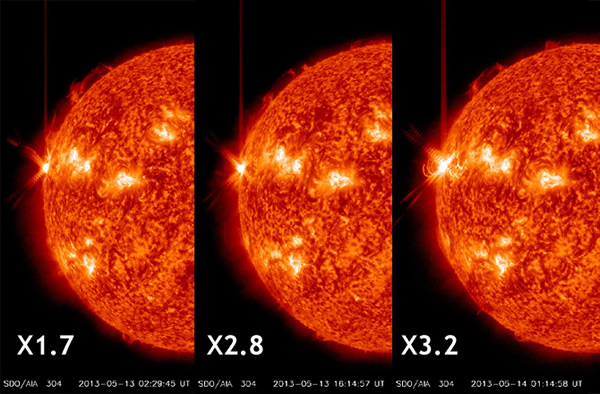Sun Unleashes THREE Record X-Class Flares
The weekend ended with the biggest solar flare of the year — an X-class flare measuring X1.7. X-class flares are the most energetic type of flare, but an X1.7 is at the lower end of that scale. Obviously disappointed by its 2013 personal best, the sun let rip with not one, but TWO more X-class flares within 24 hours, each bigger than the last.
The X1.7 erupted at 9:17 p.m. EST (Sunday), and then a X2.8 followed-up at 11:09 a.m. EST (Monday). Then, the biggest flare completed the hat-trick at 8:17 p.m. EST with a new 2013 record of X3.2. The largest flare of the day is nearly 3 times more energetic than the first X1.7 flare.
All the flares originated from the same active region — AR 1748 — which is currently crackling with intense magnetic activity. The first flare was spotted erupting just beyond the limb of the sun, but now AR 1748 is rotating into the Earth-facing side bringing with it the possibility of more flares and coronal mass ejections (CMEs).
According to Spaceweather.com, NOAA space weather forecasters estimate a 40 percent chance of further X-class flares over the next 24 hours.
Sun Unleashes THREE Record X-Class Flares
The intense X-ray emissions that are generated by flares of this type can boost ionization in the upper layers of the Earth’s atmosphere. This can, in turn, affect global communications. During periods of intense solar activity, upper layers of the atmosphere may expand, making the orbital environment unexpectedly dense, increasing drag on satellites. If left unchecked, satellites can deorbit sooner than predicted.
CME’s on the other hand are bubbles of magnetism carrying highly charged particles that can interact with our planet’s magnetic field, generating aurorae. Sometimes, if the conditions are right, geomagnetic storms can induce electric currents through the atmosphere, potentially overloading national power grids. So far, AR 1748 hasn’t generated an Earth-directed CME, but that could change over the next few days.
The sun is currently undergoing “solar maximum” — a period of peak activity in its 11 year solar cycle. So far, solar max has been mediocre at best, but as this explosive trio has just shown us, don’t count the sun out quite yet — we could be in for a period of rather inclement space weather courtesy of AR 1748.(May 14, 2013 02:54 AM ET // by Ian O'Neill)












